Leadership Comparison and Effect in Securities Industry Analysis
VerifiedAdded on 2021/04/24
|13
|2924
|89
Essay
AI Summary
This essay provides a comprehensive analysis of leadership styles, specifically focusing on their application and impact within the securities industry. The study begins with a literature review, exploring the concepts of traditional and empathic leadership, their characteristics, and the theoretical underpinnings. It then delves into the different types of traditional leadership styles, such as autocratic, democratic, strategic, transformational, team, cross-cultural, facilitative, laissez-faire, transactional, and charismatic leadership. The essay examines the application of these styles within security companies, including securities firms, banks, and asset management companies. Furthermore, the study contrasts traditional leadership with empathic leadership, highlighting the importance of motivation and support within the workplace. A comparative analysis is conducted, exploring the strengths and weaknesses of each leadership approach and their relevance to the dynamic challenges faced by the securities industry. The research question focuses on identifying the most suitable leadership approaches for security companies. The essay concludes by emphasizing the importance of adapting leadership styles to meet the evolving needs of the industry and the workforce.
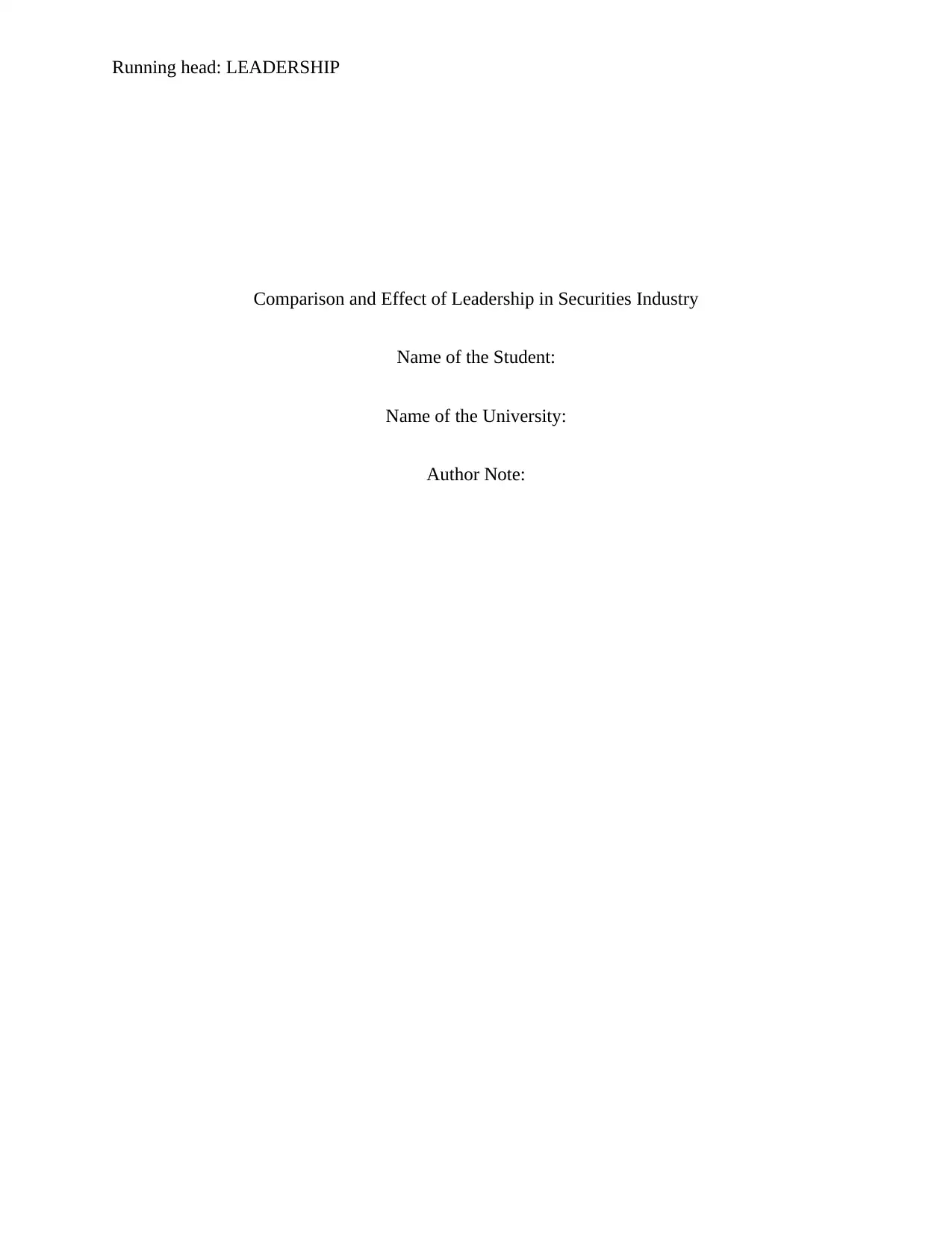
Running head: LEADERSHIP
Comparison and Effect of Leadership in Securities Industry
Name of the Student:
Name of the University:
Author Note:
Comparison and Effect of Leadership in Securities Industry
Name of the Student:
Name of the University:
Author Note:
Paraphrase This Document
Need a fresh take? Get an instant paraphrase of this document with our AI Paraphraser
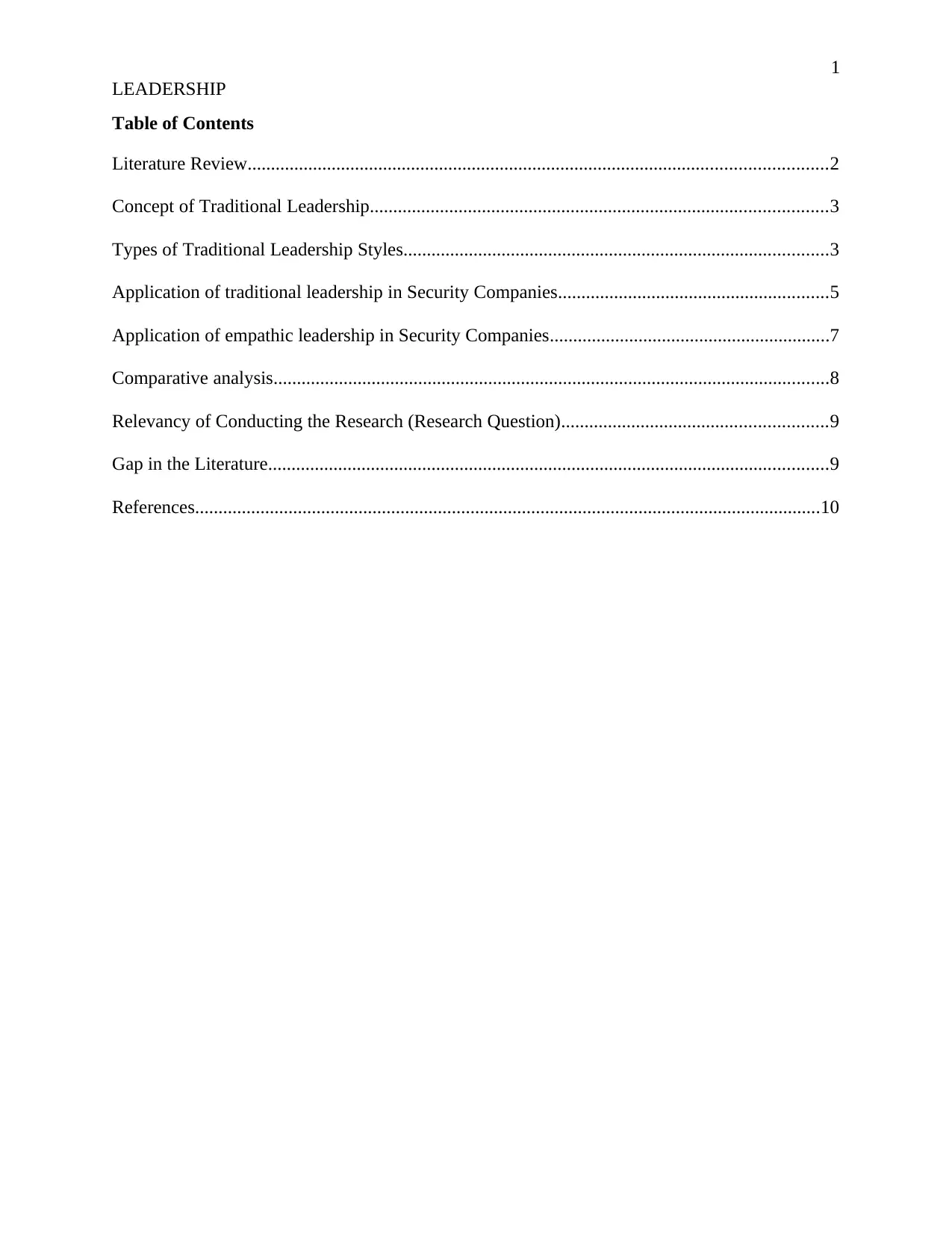
1
LEADERSHIP
Table of Contents
Literature Review............................................................................................................................2
Concept of Traditional Leadership..................................................................................................3
Types of Traditional Leadership Styles...........................................................................................3
Application of traditional leadership in Security Companies..........................................................5
Application of empathic leadership in Security Companies............................................................7
Comparative analysis.......................................................................................................................8
Relevancy of Conducting the Research (Research Question).........................................................9
Gap in the Literature........................................................................................................................9
References......................................................................................................................................10
LEADERSHIP
Table of Contents
Literature Review............................................................................................................................2
Concept of Traditional Leadership..................................................................................................3
Types of Traditional Leadership Styles...........................................................................................3
Application of traditional leadership in Security Companies..........................................................5
Application of empathic leadership in Security Companies............................................................7
Comparative analysis.......................................................................................................................8
Relevancy of Conducting the Research (Research Question).........................................................9
Gap in the Literature........................................................................................................................9
References......................................................................................................................................10
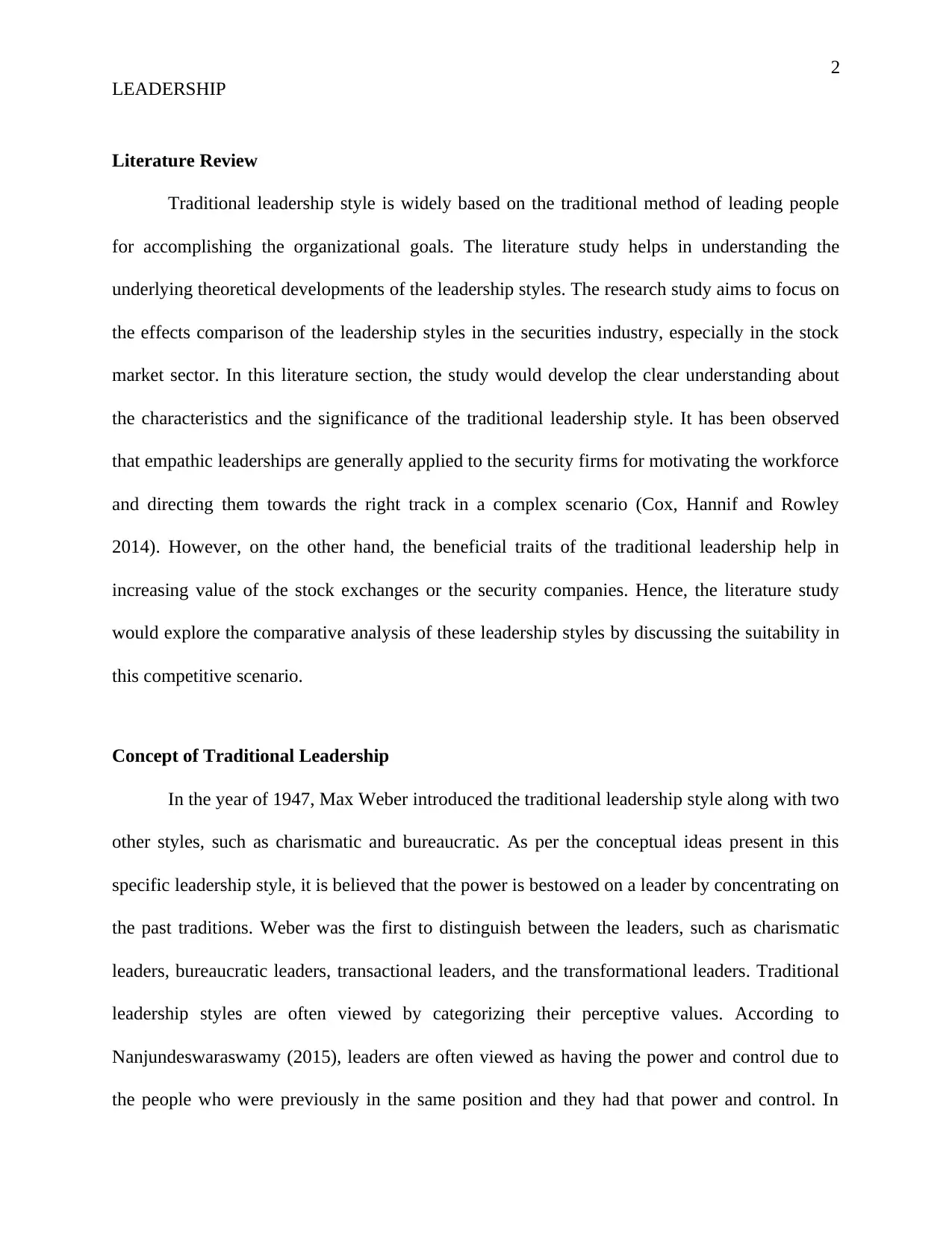
2
LEADERSHIP
Literature Review
Traditional leadership style is widely based on the traditional method of leading people
for accomplishing the organizational goals. The literature study helps in understanding the
underlying theoretical developments of the leadership styles. The research study aims to focus on
the effects comparison of the leadership styles in the securities industry, especially in the stock
market sector. In this literature section, the study would develop the clear understanding about
the characteristics and the significance of the traditional leadership style. It has been observed
that empathic leaderships are generally applied to the security firms for motivating the workforce
and directing them towards the right track in a complex scenario (Cox, Hannif and Rowley
2014). However, on the other hand, the beneficial traits of the traditional leadership help in
increasing value of the stock exchanges or the security companies. Hence, the literature study
would explore the comparative analysis of these leadership styles by discussing the suitability in
this competitive scenario.
Concept of Traditional Leadership
In the year of 1947, Max Weber introduced the traditional leadership style along with two
other styles, such as charismatic and bureaucratic. As per the conceptual ideas present in this
specific leadership style, it is believed that the power is bestowed on a leader by concentrating on
the past traditions. Weber was the first to distinguish between the leaders, such as charismatic
leaders, bureaucratic leaders, transactional leaders, and the transformational leaders. Traditional
leadership styles are often viewed by categorizing their perceptive values. According to
Nanjundeswaraswamy (2015), leaders are often viewed as having the power and control due to
the people who were previously in the same position and they had that power and control. In
LEADERSHIP
Literature Review
Traditional leadership style is widely based on the traditional method of leading people
for accomplishing the organizational goals. The literature study helps in understanding the
underlying theoretical developments of the leadership styles. The research study aims to focus on
the effects comparison of the leadership styles in the securities industry, especially in the stock
market sector. In this literature section, the study would develop the clear understanding about
the characteristics and the significance of the traditional leadership style. It has been observed
that empathic leaderships are generally applied to the security firms for motivating the workforce
and directing them towards the right track in a complex scenario (Cox, Hannif and Rowley
2014). However, on the other hand, the beneficial traits of the traditional leadership help in
increasing value of the stock exchanges or the security companies. Hence, the literature study
would explore the comparative analysis of these leadership styles by discussing the suitability in
this competitive scenario.
Concept of Traditional Leadership
In the year of 1947, Max Weber introduced the traditional leadership style along with two
other styles, such as charismatic and bureaucratic. As per the conceptual ideas present in this
specific leadership style, it is believed that the power is bestowed on a leader by concentrating on
the past traditions. Weber was the first to distinguish between the leaders, such as charismatic
leaders, bureaucratic leaders, transactional leaders, and the transformational leaders. Traditional
leadership styles are often viewed by categorizing their perceptive values. According to
Nanjundeswaraswamy (2015), leaders are often viewed as having the power and control due to
the people who were previously in the same position and they had that power and control. In
⊘ This is a preview!⊘
Do you want full access?
Subscribe today to unlock all pages.

Trusted by 1+ million students worldwide

3
LEADERSHIP
other words, as argued by Parker, Holesgrove and Pathak (2015), leaders are usually followed
not because of the individuals, but their personal loyalty to the position. The modern leadership
was originated from the industrial revolution when employees needed to follow the leaders who
were completely authoritative in making decisions. In many of the companies, the leaders follow
the fruitful leadership style selected from such traditional method. The types of the traditional
leaders and their characteristics are described further:
Types of Traditional Leadership Styles
According to Nanjundeswaraswamy and Swamy (2014), leadership style is clearly
defined by the method of leading the organisation by a person. The traditional method of leading
people is characterized by the diverse nature of the leadership. These different types of
leadership styles are as follows:
Autocratic leadership: An autocratic leader holds the entire responsibility and authority
of an organisation. Shu (2015) defined that the autocratic leaders make the decision without
consulting any other subordinate in the organisation. This leadership style has no or little
flexibility, which may sometimes create the negative impact on the working associates. Donald
Trump is an example of autocratic leader in his business and he set a new standard of excellence.
Democratic leadership: A democratic leaders consult the other subordinates to make the
relevant decision. Unlike the autocratic leadership style, this leadership style is centered on the
contribution of the other subordinates (Schedlitzki and Edwards 2017). The leadership style is
much flexible and it helps in motivating people associated with the organisation. Steve Jobs is
the most significant example of a democratic leader who regained the lost vision of Apple Inc.
LEADERSHIP
other words, as argued by Parker, Holesgrove and Pathak (2015), leaders are usually followed
not because of the individuals, but their personal loyalty to the position. The modern leadership
was originated from the industrial revolution when employees needed to follow the leaders who
were completely authoritative in making decisions. In many of the companies, the leaders follow
the fruitful leadership style selected from such traditional method. The types of the traditional
leaders and their characteristics are described further:
Types of Traditional Leadership Styles
According to Nanjundeswaraswamy and Swamy (2014), leadership style is clearly
defined by the method of leading the organisation by a person. The traditional method of leading
people is characterized by the diverse nature of the leadership. These different types of
leadership styles are as follows:
Autocratic leadership: An autocratic leader holds the entire responsibility and authority
of an organisation. Shu (2015) defined that the autocratic leaders make the decision without
consulting any other subordinate in the organisation. This leadership style has no or little
flexibility, which may sometimes create the negative impact on the working associates. Donald
Trump is an example of autocratic leader in his business and he set a new standard of excellence.
Democratic leadership: A democratic leaders consult the other subordinates to make the
relevant decision. Unlike the autocratic leadership style, this leadership style is centered on the
contribution of the other subordinates (Schedlitzki and Edwards 2017). The leadership style is
much flexible and it helps in motivating people associated with the organisation. Steve Jobs is
the most significant example of a democratic leader who regained the lost vision of Apple Inc.
Paraphrase This Document
Need a fresh take? Get an instant paraphrase of this document with our AI Paraphraser
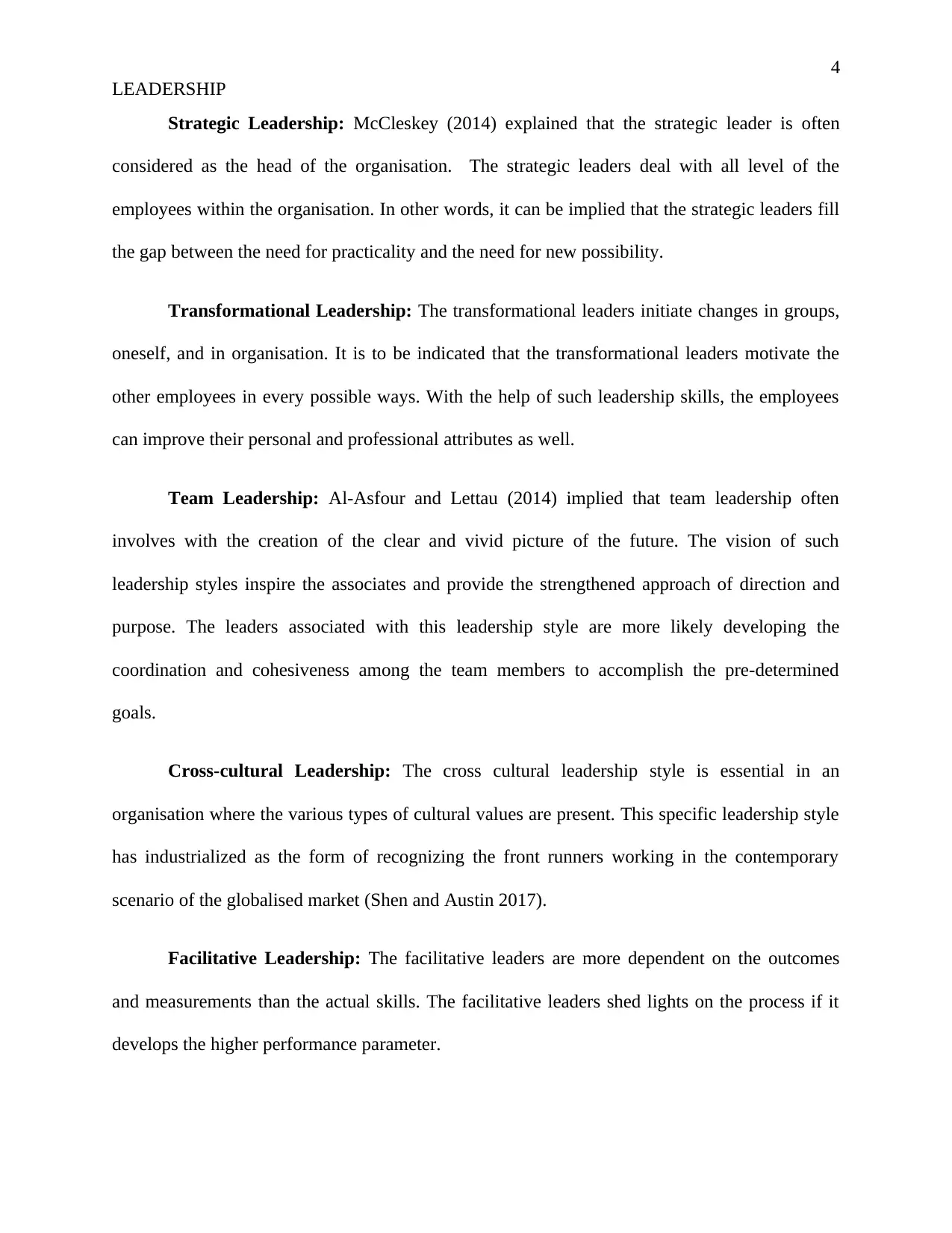
4
LEADERSHIP
Strategic Leadership: McCleskey (2014) explained that the strategic leader is often
considered as the head of the organisation. The strategic leaders deal with all level of the
employees within the organisation. In other words, it can be implied that the strategic leaders fill
the gap between the need for practicality and the need for new possibility.
Transformational Leadership: The transformational leaders initiate changes in groups,
oneself, and in organisation. It is to be indicated that the transformational leaders motivate the
other employees in every possible ways. With the help of such leadership skills, the employees
can improve their personal and professional attributes as well.
Team Leadership: Al-Asfour and Lettau (2014) implied that team leadership often
involves with the creation of the clear and vivid picture of the future. The vision of such
leadership styles inspire the associates and provide the strengthened approach of direction and
purpose. The leaders associated with this leadership style are more likely developing the
coordination and cohesiveness among the team members to accomplish the pre-determined
goals.
Cross-cultural Leadership: The cross cultural leadership style is essential in an
organisation where the various types of cultural values are present. This specific leadership style
has industrialized as the form of recognizing the front runners working in the contemporary
scenario of the globalised market (Shen and Austin 2017).
Facilitative Leadership: The facilitative leaders are more dependent on the outcomes
and measurements than the actual skills. The facilitative leaders shed lights on the process if it
develops the higher performance parameter.
LEADERSHIP
Strategic Leadership: McCleskey (2014) explained that the strategic leader is often
considered as the head of the organisation. The strategic leaders deal with all level of the
employees within the organisation. In other words, it can be implied that the strategic leaders fill
the gap between the need for practicality and the need for new possibility.
Transformational Leadership: The transformational leaders initiate changes in groups,
oneself, and in organisation. It is to be indicated that the transformational leaders motivate the
other employees in every possible ways. With the help of such leadership skills, the employees
can improve their personal and professional attributes as well.
Team Leadership: Al-Asfour and Lettau (2014) implied that team leadership often
involves with the creation of the clear and vivid picture of the future. The vision of such
leadership styles inspire the associates and provide the strengthened approach of direction and
purpose. The leaders associated with this leadership style are more likely developing the
coordination and cohesiveness among the team members to accomplish the pre-determined
goals.
Cross-cultural Leadership: The cross cultural leadership style is essential in an
organisation where the various types of cultural values are present. This specific leadership style
has industrialized as the form of recognizing the front runners working in the contemporary
scenario of the globalised market (Shen and Austin 2017).
Facilitative Leadership: The facilitative leaders are more dependent on the outcomes
and measurements than the actual skills. The facilitative leaders shed lights on the process if it
develops the higher performance parameter.

5
LEADERSHIP
Laissez-faire Leadership: In a laissez-faire leadership style, the employees receive the
authority to work according to their ability (Lappalainen 2015). The leadership style lacks the
closer supervision due to which it is often perceived as less satisfying and least effective.
Transactional Leadership: Transactional leadership involves the exchange process
whereby the followers receive the tangible rewards and immediate result out of the orders of
their leaders.
Charismatic Leadership: The charismatic leaders manifest the revolutionary power that
transforms the values and beliefs of the followers. The charismatic leaders have the potentiality
to improve the visionary and modify the working forms of the associated to derive more benefits.
Application of traditional leadership in Security Companies
Maintenance of the high empathy is essential for a leader while working in an
organisation with all other associates. Security Industry includes the securities firms, banks and
asset management companies. These companies serve the public and private clients armed and
unarmed services of security (Guinalíu and Jordán 2016). The security industry being combined
with Financial Markets Association forms a United States industry trade group and represents
various kinds of security industries. The traditional leadership approach in the security company
can be interpreted in diverse ways. For example, the transformational leaders help the employees
to develop their professional and personal skills. The complex technicalities utilized in the
security company is a suitable platform for these leaders to enhance the knowledge of the
employees by providing them the fruitful training session (Buble, Juras and Matić 2014). On the
other hand, the transactional leaders can reward or punish the employees as per their
LEADERSHIP
Laissez-faire Leadership: In a laissez-faire leadership style, the employees receive the
authority to work according to their ability (Lappalainen 2015). The leadership style lacks the
closer supervision due to which it is often perceived as less satisfying and least effective.
Transactional Leadership: Transactional leadership involves the exchange process
whereby the followers receive the tangible rewards and immediate result out of the orders of
their leaders.
Charismatic Leadership: The charismatic leaders manifest the revolutionary power that
transforms the values and beliefs of the followers. The charismatic leaders have the potentiality
to improve the visionary and modify the working forms of the associated to derive more benefits.
Application of traditional leadership in Security Companies
Maintenance of the high empathy is essential for a leader while working in an
organisation with all other associates. Security Industry includes the securities firms, banks and
asset management companies. These companies serve the public and private clients armed and
unarmed services of security (Guinalíu and Jordán 2016). The security industry being combined
with Financial Markets Association forms a United States industry trade group and represents
various kinds of security industries. The traditional leadership approach in the security company
can be interpreted in diverse ways. For example, the transformational leaders help the employees
to develop their professional and personal skills. The complex technicalities utilized in the
security company is a suitable platform for these leaders to enhance the knowledge of the
employees by providing them the fruitful training session (Buble, Juras and Matić 2014). On the
other hand, the transactional leaders can reward or punish the employees as per their
⊘ This is a preview!⊘
Do you want full access?
Subscribe today to unlock all pages.

Trusted by 1+ million students worldwide

6
LEADERSHIP
performance outcome. Security Company testifies such ability of the employees and provide the
insight of selecting right leadership approach.
The hypothesis of the research concentrates on the differences between the empathic
leadership and traditional leadership. It has been identified that the traditional approaches in the
leadership style provides the diverse scenario in which the leaders can collaborate with the
workforce. The closer supervision with the workforce helps in creating the vision for future.
Yahaya and Ebrahim (2016) implied that leaders need to maintain the empathy but need to
follow the right track of leading people. The security companies develop solutions for the
business problems or protecting the confidential data. In many of the cases, the security
companies deal with the technological aspects that require proper training and skilled attributes
of the workers. The application of the traditional leadership helps in developing such efficiency
skills of the associated employees. The traditional leaders provide the effective training session
or monitor the activities of the employees in order to bring more improvement in their
performance (McFadden, Stock and Gowen III 2015). The traditional leaders, with their diverse
attributes, help the associates to improve their personal and professional skills for generating
high end performance outcome. The traditional leaders provide the insights and work on
upgrading the attributes of the workforce. The security companies require building trust and
reliability to provide the necessary services or solutions. The traditional leaders play the most
important role in developing the effectiveness among the workers. Therefore, the security
companies require adopting the traditional leadership to build reliability and high standard work
ethics.
LEADERSHIP
performance outcome. Security Company testifies such ability of the employees and provide the
insight of selecting right leadership approach.
The hypothesis of the research concentrates on the differences between the empathic
leadership and traditional leadership. It has been identified that the traditional approaches in the
leadership style provides the diverse scenario in which the leaders can collaborate with the
workforce. The closer supervision with the workforce helps in creating the vision for future.
Yahaya and Ebrahim (2016) implied that leaders need to maintain the empathy but need to
follow the right track of leading people. The security companies develop solutions for the
business problems or protecting the confidential data. In many of the cases, the security
companies deal with the technological aspects that require proper training and skilled attributes
of the workers. The application of the traditional leadership helps in developing such efficiency
skills of the associated employees. The traditional leaders provide the effective training session
or monitor the activities of the employees in order to bring more improvement in their
performance (McFadden, Stock and Gowen III 2015). The traditional leaders, with their diverse
attributes, help the associates to improve their personal and professional skills for generating
high end performance outcome. The traditional leaders provide the insights and work on
upgrading the attributes of the workforce. The security companies require building trust and
reliability to provide the necessary services or solutions. The traditional leaders play the most
important role in developing the effectiveness among the workers. Therefore, the security
companies require adopting the traditional leadership to build reliability and high standard work
ethics.
Paraphrase This Document
Need a fresh take? Get an instant paraphrase of this document with our AI Paraphraser

7
LEADERSHIP
Application of empathic leadership in Security Companies
The empathic leadership style depends on the directive and motivational aspects. In order
to create the higher level of motivation, the leaders need to consider the situation and the specific
direct at the beginning. The empathic leadership style includes the coaching leadership,
delegating leadership, instructive leadership, and supportive leadership. Presence of these
attributes help in creating the high level of motivation within the workplace. According to
Northouse (2018), empathic leaders identifies the needs of the motivation and provides the
supports to the associates. In a security company, the techniques used for performing
functionalities are quite complex. The empathic leaders need to decide the method of supporting
the workers as per the situations. For instance, when one employee requires directive leadership
at the initial stage, it is essential to provide the right direction before allocating any job. The
supports from the empathic leaders are necessary in such circumstances.
While applied on the security companies, the empathic leaders need to develop the right
direction and enriched knowledge about the security services and technological skills.
Developing the higher skills in a dynamic and complex scenario creates the greater impacts on
the minds of the employees. Khan and Adnan (2014) explained that the empathic leaders share
the information with the associates to generate the sense of responsibility and direct efficiency
for performing in a better manner. Security companies require the staffs that are quite
responsible towards their works and maintain confidentiality while working any security
projects. During the development of any complex project or high level of security services that
are needed to be delivered to the potential clients, the security company requires the association
of empathic leaders.
LEADERSHIP
Application of empathic leadership in Security Companies
The empathic leadership style depends on the directive and motivational aspects. In order
to create the higher level of motivation, the leaders need to consider the situation and the specific
direct at the beginning. The empathic leadership style includes the coaching leadership,
delegating leadership, instructive leadership, and supportive leadership. Presence of these
attributes help in creating the high level of motivation within the workplace. According to
Northouse (2018), empathic leaders identifies the needs of the motivation and provides the
supports to the associates. In a security company, the techniques used for performing
functionalities are quite complex. The empathic leaders need to decide the method of supporting
the workers as per the situations. For instance, when one employee requires directive leadership
at the initial stage, it is essential to provide the right direction before allocating any job. The
supports from the empathic leaders are necessary in such circumstances.
While applied on the security companies, the empathic leaders need to develop the right
direction and enriched knowledge about the security services and technological skills.
Developing the higher skills in a dynamic and complex scenario creates the greater impacts on
the minds of the employees. Khan and Adnan (2014) explained that the empathic leaders share
the information with the associates to generate the sense of responsibility and direct efficiency
for performing in a better manner. Security companies require the staffs that are quite
responsible towards their works and maintain confidentiality while working any security
projects. During the development of any complex project or high level of security services that
are needed to be delivered to the potential clients, the security company requires the association
of empathic leaders.
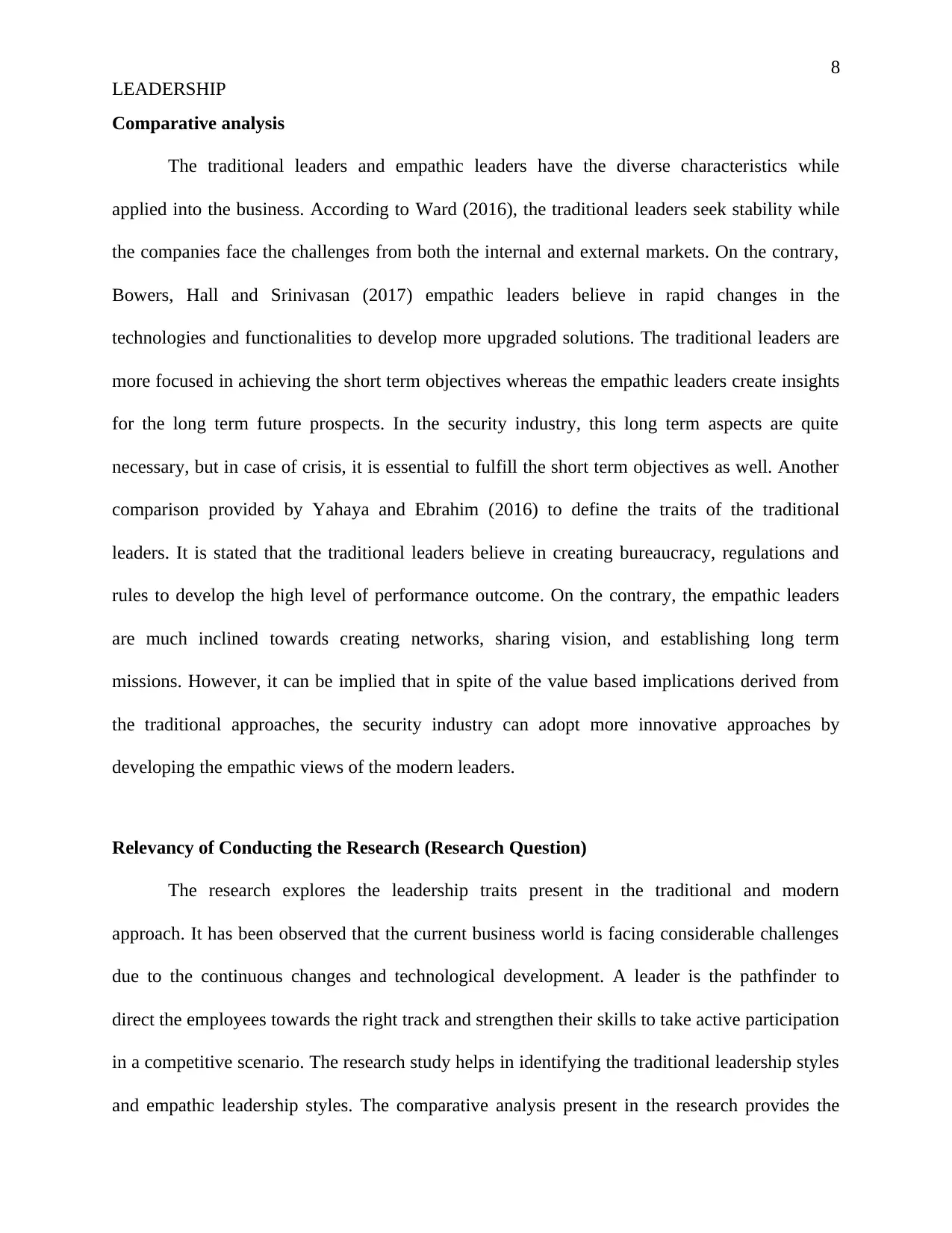
8
LEADERSHIP
Comparative analysis
The traditional leaders and empathic leaders have the diverse characteristics while
applied into the business. According to Ward (2016), the traditional leaders seek stability while
the companies face the challenges from both the internal and external markets. On the contrary,
Bowers, Hall and Srinivasan (2017) empathic leaders believe in rapid changes in the
technologies and functionalities to develop more upgraded solutions. The traditional leaders are
more focused in achieving the short term objectives whereas the empathic leaders create insights
for the long term future prospects. In the security industry, this long term aspects are quite
necessary, but in case of crisis, it is essential to fulfill the short term objectives as well. Another
comparison provided by Yahaya and Ebrahim (2016) to define the traits of the traditional
leaders. It is stated that the traditional leaders believe in creating bureaucracy, regulations and
rules to develop the high level of performance outcome. On the contrary, the empathic leaders
are much inclined towards creating networks, sharing vision, and establishing long term
missions. However, it can be implied that in spite of the value based implications derived from
the traditional approaches, the security industry can adopt more innovative approaches by
developing the empathic views of the modern leaders.
Relevancy of Conducting the Research (Research Question)
The research explores the leadership traits present in the traditional and modern
approach. It has been observed that the current business world is facing considerable challenges
due to the continuous changes and technological development. A leader is the pathfinder to
direct the employees towards the right track and strengthen their skills to take active participation
in a competitive scenario. The research study helps in identifying the traditional leadership styles
and empathic leadership styles. The comparative analysis present in the research provides the
LEADERSHIP
Comparative analysis
The traditional leaders and empathic leaders have the diverse characteristics while
applied into the business. According to Ward (2016), the traditional leaders seek stability while
the companies face the challenges from both the internal and external markets. On the contrary,
Bowers, Hall and Srinivasan (2017) empathic leaders believe in rapid changes in the
technologies and functionalities to develop more upgraded solutions. The traditional leaders are
more focused in achieving the short term objectives whereas the empathic leaders create insights
for the long term future prospects. In the security industry, this long term aspects are quite
necessary, but in case of crisis, it is essential to fulfill the short term objectives as well. Another
comparison provided by Yahaya and Ebrahim (2016) to define the traits of the traditional
leaders. It is stated that the traditional leaders believe in creating bureaucracy, regulations and
rules to develop the high level of performance outcome. On the contrary, the empathic leaders
are much inclined towards creating networks, sharing vision, and establishing long term
missions. However, it can be implied that in spite of the value based implications derived from
the traditional approaches, the security industry can adopt more innovative approaches by
developing the empathic views of the modern leaders.
Relevancy of Conducting the Research (Research Question)
The research explores the leadership traits present in the traditional and modern
approach. It has been observed that the current business world is facing considerable challenges
due to the continuous changes and technological development. A leader is the pathfinder to
direct the employees towards the right track and strengthen their skills to take active participation
in a competitive scenario. The research study helps in identifying the traditional leadership styles
and empathic leadership styles. The comparative analysis present in the research provides the
⊘ This is a preview!⊘
Do you want full access?
Subscribe today to unlock all pages.

Trusted by 1+ million students worldwide
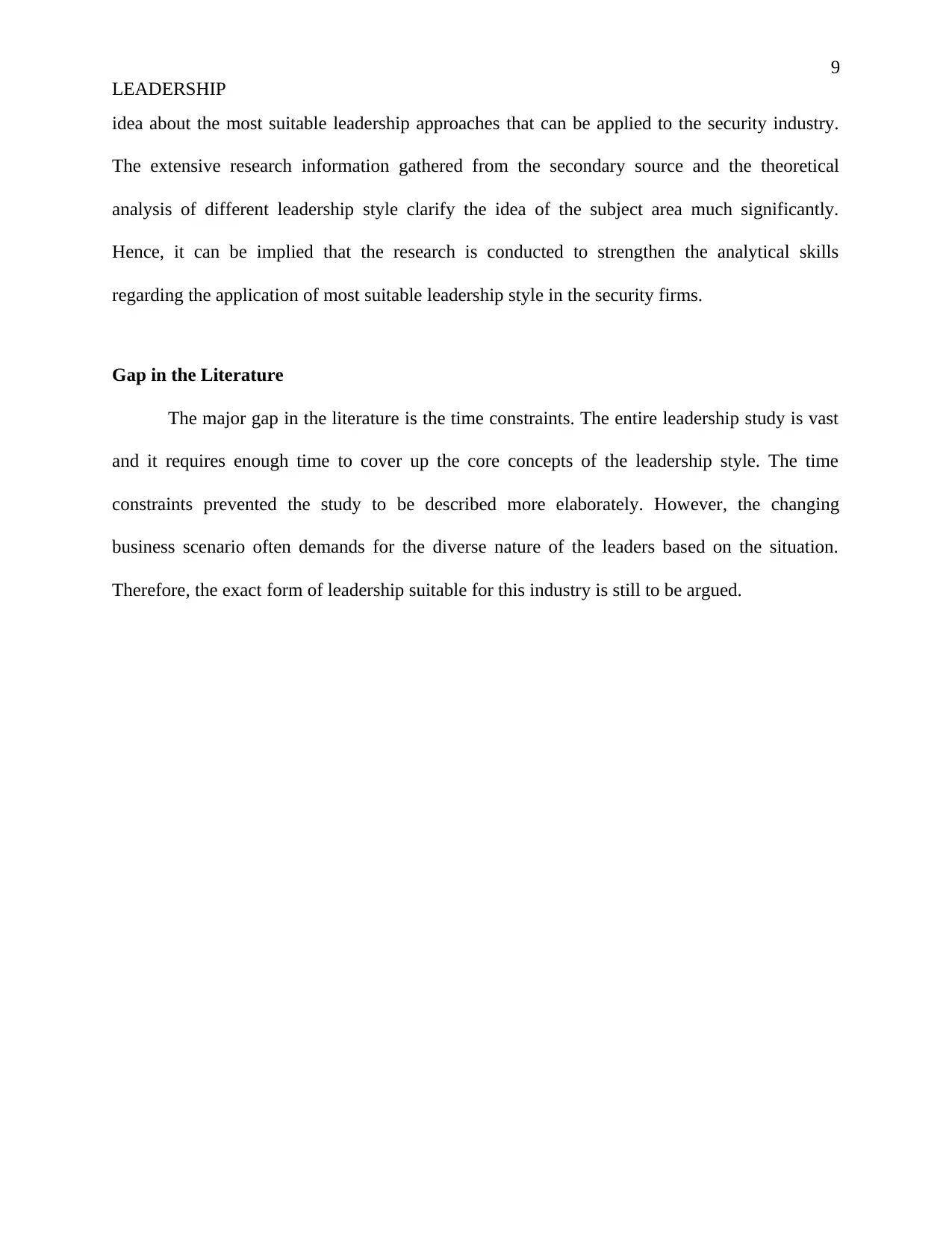
9
LEADERSHIP
idea about the most suitable leadership approaches that can be applied to the security industry.
The extensive research information gathered from the secondary source and the theoretical
analysis of different leadership style clarify the idea of the subject area much significantly.
Hence, it can be implied that the research is conducted to strengthen the analytical skills
regarding the application of most suitable leadership style in the security firms.
Gap in the Literature
The major gap in the literature is the time constraints. The entire leadership study is vast
and it requires enough time to cover up the core concepts of the leadership style. The time
constraints prevented the study to be described more elaborately. However, the changing
business scenario often demands for the diverse nature of the leaders based on the situation.
Therefore, the exact form of leadership suitable for this industry is still to be argued.
LEADERSHIP
idea about the most suitable leadership approaches that can be applied to the security industry.
The extensive research information gathered from the secondary source and the theoretical
analysis of different leadership style clarify the idea of the subject area much significantly.
Hence, it can be implied that the research is conducted to strengthen the analytical skills
regarding the application of most suitable leadership style in the security firms.
Gap in the Literature
The major gap in the literature is the time constraints. The entire leadership study is vast
and it requires enough time to cover up the core concepts of the leadership style. The time
constraints prevented the study to be described more elaborately. However, the changing
business scenario often demands for the diverse nature of the leaders based on the situation.
Therefore, the exact form of leadership suitable for this industry is still to be argued.
Paraphrase This Document
Need a fresh take? Get an instant paraphrase of this document with our AI Paraphraser

10
LEADERSHIP
References
Al-Asfour, A. and Lettau, L., 2014. Strategies for leadership styles for multi-generational
workforce. Journal of Leadership, Accountability and Ethics, 11(2), p.58.
Bowers, M.R., Hall, J.R. and Srinivasan, M.M., 2017. Organizational culture and leadership
style: The missing combination for selecting the right leader for effective crisis
management. Business Horizons, 60(4), pp.551-563.
Buble, M., Juras, A. and Matić, I., 2014. The relationship between managers’ leadership styles
and motivation. Management: journal of contemporary management issues, 19(1), pp.161-193.
Cox, A., Hannif, Z. and Rowley, C., 2014. Leadership styles and generational effects: Examples
of US companies in Vietnam. The International Journal of Human Resource
Management, 25(1), pp.1-22.
Guinalíu, M. and Jordán, P., 2016. Building trust in the leader of virtual work teams. Spanish
Journal of Marketing-ESIC, 20(1), pp.58-70.
Khan, A.Z. and Adnan, N., 2014. Impact of leadership styles on organizational
performance. International Journal of Management Sciences, 2(11), pp.501-515.
Lappalainen, P., 2015. Predictors of effective leadership in industry–should engineering
education focus on traditional intelligence, personality, or emotional intelligence?. European
Journal of Engineering Education, 40(2), pp.222-233.
McCleskey, J.A., 2014. Situational, transformational, and transactional leadership and leadership
development. Journal of Business Studies Quarterly, 5(4), p.117.
LEADERSHIP
References
Al-Asfour, A. and Lettau, L., 2014. Strategies for leadership styles for multi-generational
workforce. Journal of Leadership, Accountability and Ethics, 11(2), p.58.
Bowers, M.R., Hall, J.R. and Srinivasan, M.M., 2017. Organizational culture and leadership
style: The missing combination for selecting the right leader for effective crisis
management. Business Horizons, 60(4), pp.551-563.
Buble, M., Juras, A. and Matić, I., 2014. The relationship between managers’ leadership styles
and motivation. Management: journal of contemporary management issues, 19(1), pp.161-193.
Cox, A., Hannif, Z. and Rowley, C., 2014. Leadership styles and generational effects: Examples
of US companies in Vietnam. The International Journal of Human Resource
Management, 25(1), pp.1-22.
Guinalíu, M. and Jordán, P., 2016. Building trust in the leader of virtual work teams. Spanish
Journal of Marketing-ESIC, 20(1), pp.58-70.
Khan, A.Z. and Adnan, N., 2014. Impact of leadership styles on organizational
performance. International Journal of Management Sciences, 2(11), pp.501-515.
Lappalainen, P., 2015. Predictors of effective leadership in industry–should engineering
education focus on traditional intelligence, personality, or emotional intelligence?. European
Journal of Engineering Education, 40(2), pp.222-233.
McCleskey, J.A., 2014. Situational, transformational, and transactional leadership and leadership
development. Journal of Business Studies Quarterly, 5(4), p.117.
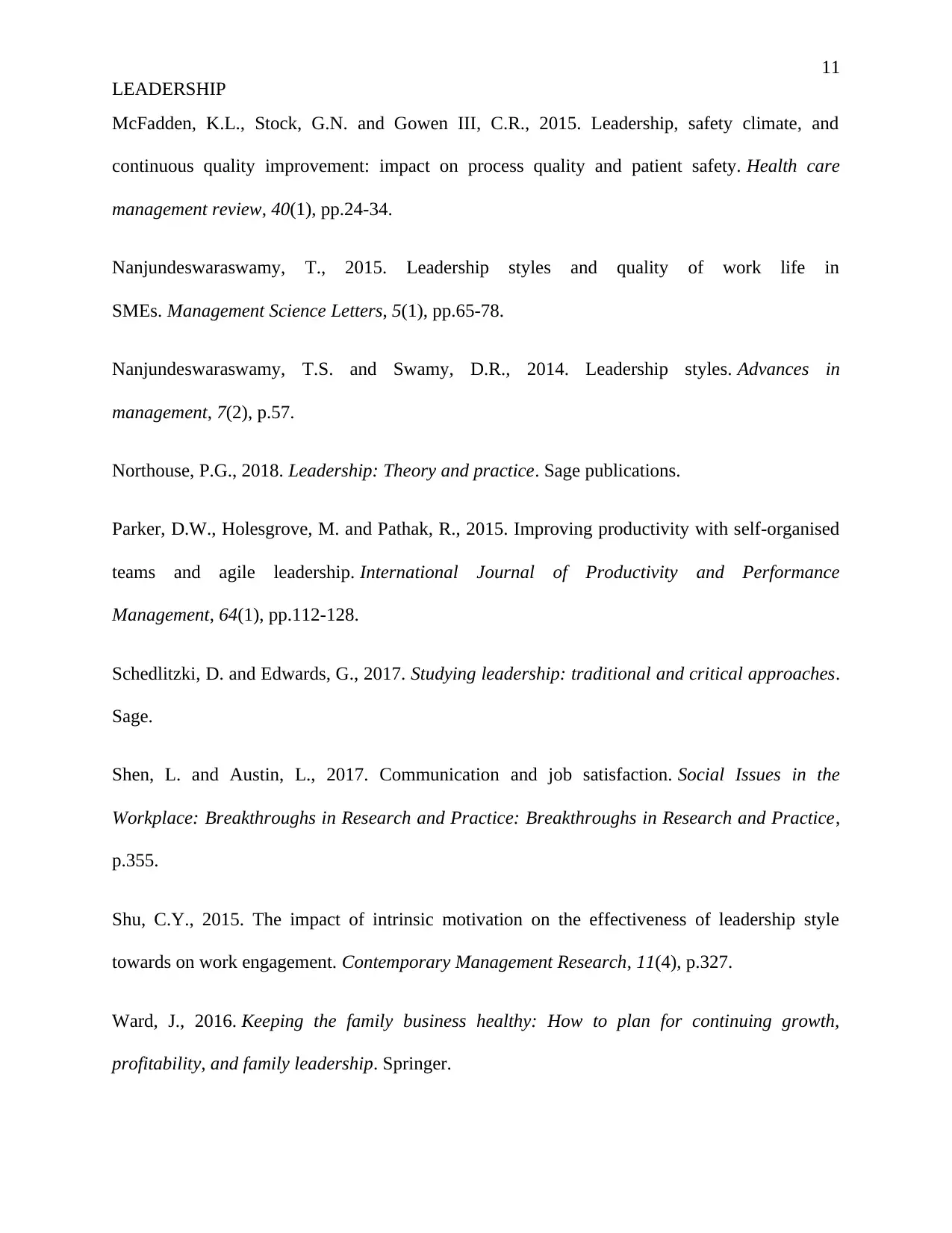
11
LEADERSHIP
McFadden, K.L., Stock, G.N. and Gowen III, C.R., 2015. Leadership, safety climate, and
continuous quality improvement: impact on process quality and patient safety. Health care
management review, 40(1), pp.24-34.
Nanjundeswaraswamy, T., 2015. Leadership styles and quality of work life in
SMEs. Management Science Letters, 5(1), pp.65-78.
Nanjundeswaraswamy, T.S. and Swamy, D.R., 2014. Leadership styles. Advances in
management, 7(2), p.57.
Northouse, P.G., 2018. Leadership: Theory and practice. Sage publications.
Parker, D.W., Holesgrove, M. and Pathak, R., 2015. Improving productivity with self-organised
teams and agile leadership. International Journal of Productivity and Performance
Management, 64(1), pp.112-128.
Schedlitzki, D. and Edwards, G., 2017. Studying leadership: traditional and critical approaches.
Sage.
Shen, L. and Austin, L., 2017. Communication and job satisfaction. Social Issues in the
Workplace: Breakthroughs in Research and Practice: Breakthroughs in Research and Practice,
p.355.
Shu, C.Y., 2015. The impact of intrinsic motivation on the effectiveness of leadership style
towards on work engagement. Contemporary Management Research, 11(4), p.327.
Ward, J., 2016. Keeping the family business healthy: How to plan for continuing growth,
profitability, and family leadership. Springer.
LEADERSHIP
McFadden, K.L., Stock, G.N. and Gowen III, C.R., 2015. Leadership, safety climate, and
continuous quality improvement: impact on process quality and patient safety. Health care
management review, 40(1), pp.24-34.
Nanjundeswaraswamy, T., 2015. Leadership styles and quality of work life in
SMEs. Management Science Letters, 5(1), pp.65-78.
Nanjundeswaraswamy, T.S. and Swamy, D.R., 2014. Leadership styles. Advances in
management, 7(2), p.57.
Northouse, P.G., 2018. Leadership: Theory and practice. Sage publications.
Parker, D.W., Holesgrove, M. and Pathak, R., 2015. Improving productivity with self-organised
teams and agile leadership. International Journal of Productivity and Performance
Management, 64(1), pp.112-128.
Schedlitzki, D. and Edwards, G., 2017. Studying leadership: traditional and critical approaches.
Sage.
Shen, L. and Austin, L., 2017. Communication and job satisfaction. Social Issues in the
Workplace: Breakthroughs in Research and Practice: Breakthroughs in Research and Practice,
p.355.
Shu, C.Y., 2015. The impact of intrinsic motivation on the effectiveness of leadership style
towards on work engagement. Contemporary Management Research, 11(4), p.327.
Ward, J., 2016. Keeping the family business healthy: How to plan for continuing growth,
profitability, and family leadership. Springer.
⊘ This is a preview!⊘
Do you want full access?
Subscribe today to unlock all pages.

Trusted by 1+ million students worldwide
1 out of 13
Related Documents
Your All-in-One AI-Powered Toolkit for Academic Success.
+13062052269
info@desklib.com
Available 24*7 on WhatsApp / Email
![[object Object]](/_next/static/media/star-bottom.7253800d.svg)
Unlock your academic potential
Copyright © 2020–2025 A2Z Services. All Rights Reserved. Developed and managed by ZUCOL.




